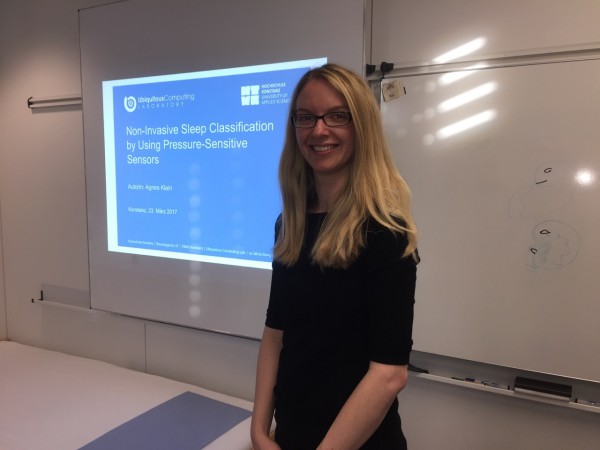Non-invasive Sleep Phase Detection
Konsanz, March 23, 2017. Non-invasive Sleep Phase Detection by Using Pressure-Sensitive Sensors was the topic of the presentation of Agnes Klein's Master Thesis. Agnes says that she investigated on a new approach to classify sleep phases, based on the parameters of body movement, heartbeat and respiration. She would like to propose her approach as a first step to offer light-weighted alternatives to classical overnight polysomnography (PSG). She could show that even with a reduced set of parameters mean agreement ratios of sleep phases detection can lead to promising results. The work has been supervised in cooperation by Prof Dr. Ralf Seepold (HTWG Konstanz) and Prof. Dr. Thomas Penzel (Charité - Universitätsmedizin Berlin).

Agnes Klein during the presentation of the results
Short abstract
In order to make reliable statements about the quality of a person’s sleep, itis essential to analyse the sleep stages and their durations. Such sleep studies are usually done in sleep laboratories. The established and gold standard procedure for sleep stage scoring is overnight polysomnography (PSG) with the Rechtschaffen and Kales (R-K) method. Unfortunately, the conduct of PSG is time-consuming and unfamiliar for the subjects and might have an impact of the recorded data. Therefore, it is important to make further investigations in low-cost home diagnostic systems to avoid the disadvantages with PSG. For this intention, it is necessary to find suitable bio vital parameters, which can be recorded with non-invasive methods and are able to classify sleep stages at the same time. The aim of this thesis is to find a new approach to classify sleep phases, based on the parameters body movement, heartbeat and respiration, due to the promising results in several publications. Therefore, 17 whole-night PSG recordings - obtained from the Sleep Medicine Center of the Charité in Berlin- where analysed in the light of heartbeat, body movement and respiration with 10 different features. Finally, multinomial regression analysis (MLR) were used to classify the sleep in 3 and 4 stages.

